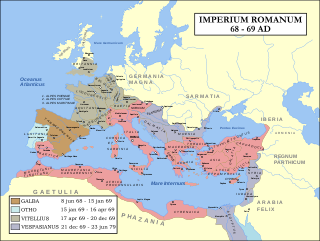Related Research Articles

Aulus Vitellius was Roman emperor for eight months, from 19 April to 20 December AD 69. Vitellius became emperor following the quick succession of the previous emperors Galba and Otho, in a year of civil war known as the Year of the Four Emperors. Vitellius added the honorific Germanicus to his name instead of Caesar upon his accession. Like his predecessor, Otho, Vitellius attempted to rally public support to his cause by honoring and imitating Nero who remained popular in the empire.

AD 69 (LXIX) was a common year starting on Sunday of the Julian calendar. In the Roman Empire, it was known as the Year of the consulship of Galba and Vinius. The denomination AD 69 for this year has been used since the early medieval period, when the Anno Domini calendar era became the prevalent method in Europe for naming years.

The 60s decade ran from January 1, AD 60, to December 31, AD 69.
Gaius Calpurnius Piso was a Roman senator in the first century. He was the focal figure in the Pisonian conspiracy of AD 65, the most famous and wide-ranging plot against the throne of Emperor Nero.

The Year of the Four Emperors, AD 69, was the first civil war of the Roman Empire, during which four emperors ruled in succession: Galba, Otho, Vitellius, and Vespasian. It is considered an important interval, marking the transition from the Julio-Claudians, the first imperial dynasty, to the Flavian dynasty. The period witnessed several rebellions and claimants, with shifting allegiances and widespread turmoil in Rome and the provinces.

Lucius Calpurnius Piso Caesoninus was a prominent Roman senator of the early Empire. His tenure as pontifex led him sometimes to be called Lucius Calpurnius Piso Pontifex, to differentiate him from his contemporary, Lucius Calpurnius Piso the Augur, consul in 1 BC. He was a confidant of the emperors Augustus and Tiberius.
Gaius Licinius Mucianus was a Roman general, statesman and writer. He is considered to have played a role behind the scenes in the elevation of Vespasian to the throne.

The gens Calpurnia was a plebeian family at ancient Rome, which first appears in history during the third century BC. The first of the gens to obtain the consulship was Gaius Calpurnius Piso in 180 BC, but from this time their consulships were very frequent, and the family of the Pisones became one of the most illustrious in the Roman state. Two important pieces of Republican legislation, the lex Calpurnia of 149 BC and lex Acilia Calpurnia of 67 BC were passed by members of the gens.
Lucius Calpurnius Piso Frugi Licinianus (38–69) was a Roman nobleman who lived in the 1st century. His adoption by the Roman emperor Galba on 10 January 69 AD precipitated their joint murder by Otho, who had expected to be adopted instead. Otho then became the second emperor of the Year of the Four Emperors.
Licinia is the name used by ancient Roman women of the gens Licinia.
Scribonia Magna, known in modern historical sources as Scribonia Crassi, was a Roman noblewoman. Scribonia was descended from Pompey.
Marcus Licinius Crassus Frugi was a Roman nobleman of consular rank who lived during the Roman Empire. Frugi's mother was an unnamed Roman woman, while his father was consul and governor Marcus Licinius Crassus Frugi. Frugi's adoptive paternal grandfather was consul and general Marcus Licinius Crassus the Younger. Crassus was the grandson of triumvir Marcus Licinius Crassus and the last known direct descendant of his grandfather. He had a daughter called Licinia who married the consul Lucius Calpurnius Piso; their son, Gaius Calpurnius Piso, was a conspirator against the Emperor Nero.

The Cancelleria Reliefs are a set of two incomplete bas-reliefs, believed to have been commissioned by the Roman Emperor Domitian. The reliefs originally depicted events from the life and reign of Domitian, but were partially recarved following the accession of emperor Nerva. They are now in the Vatican Museums.
Lucius Calpurnius Piso Frugi was a Roman politician and historian. He created the first permanent jury court in Rome to try cases related to provincial corruption during his plebeian tribunate in 146 BC. He also fought, not entirely successfully, in the First Servile War. He was consul in 133 BC and censor in 120 BC.

The gens Antonia was a Roman family of great antiquity, with both patrician and plebeian branches. The first of the gens to achieve prominence was Titus Antonius Merenda, one of the second group of Decemviri called, in 450 BC, to help draft what became the Law of the Twelve Tables. The most prominent member of the gens was Marcus Antonius.
He was born Gnaeus Calpurnius Piso and was son of Gnaeus Calpurnius Piso, but after his father's death had to take the name Lucius Calpurnius Piso.

The gens Nonia was a plebeian family at ancient Rome. Its members first appear in history toward the end of the Republic. The first of the Nonii to obtain the consulship was Lucius Nonius Asprenas in 36 BC. From then until the end of the fourth century, they regularly held the highest offices of the Roman state.

Lucius Calpurnius Piso was a Roman senator active in the first century AD. During the Year of Four Emperors he was governor of Africa and supported Vitellius. After the death of Vitellius he was killed by supporters of Vespasian.
Aulus Ducenius Geminus was a Roman senator active in the first century AD. Geminus is best known as Galba's appointment as Urban prefect of Rome during the Year of Four Emperors.
References
- ↑ Tacitus, Annales , IV.49
- ↑ Cooley, Alison E., ed. (2023). The Senatus Consultum de Cn. Pisone Patre: Text, Translation, and Commentary. Cambridge University Press. p. 99. ISBN 9781108494458 . Retrieved 2023-05-08.
- ↑ Rudich, Vasily (2005). Political Dissidence Under Nero: The Price of Dissimulation. Taylor & Francis. p. 123. ISBN 9781134914517 . Retrieved 2023-05-08.
- ↑ Levick, Barbara (2016). Vespasian. Taylor & Francis. p. 90. ISBN 9781317481348 . Retrieved 2023-05-08.
- ↑ Barrett, Anthony A.; Fantham, Elaine; Yardley, John C., eds. (2016). The Emperor Nero: A Guide to the Ancient Sources. Princeton University Press. p. 223. ISBN 9781400881109 . Retrieved 2023-05-08.
- ↑ Bowman, Alan K.; Lintott, Andrew; Champlin, Edward, eds. (1996). The Cambridge Ancient History. Vol. 10. Cambridge University Press. p. 280. ISBN 9780521264303 . Retrieved 2023-05-08.
- ↑ Tacitus, Annales , iv. 11